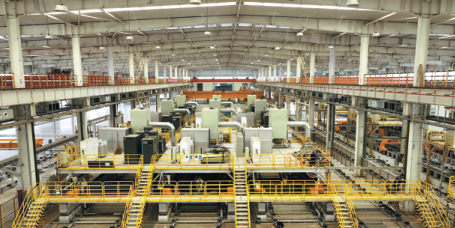Firms reaping benefits of SOE reform initiative

An intelligent manufacturing facility of Taiyuan Heavy Industry Group. [Photo by Zhang Zhibin for China Daily]
Three years after Shanxi launched a crucial initiative for the reform of State-owned enterprises, the local SOEs reported brilliant performances at the end of last year.
Statistics from the Shanxi State-owned Assets Supervision and Administration Commission show that the provincial SOEs under its administration reported total assets of 3.67 trillion yuan ($541 billion) by December 2022, growing 3.2 percent year-on-year. Their total owners' equity amounted to 1.02 trillion yuan, up 8.2 percent.
These companies reported a combined business revenue of 1.53 trillion yuan by the end of last year, growing 2.8 percent from the previous year. And their total profits amounted to 100.78 billion yuan, increasing 106.5 percent year-on-year.
The commission also reported that the provincial SOEs ranked sixth, sixth, third and sixth in the country in terms of total assets, business revenue, total profits and net profit in November last year.
The commission's officials said the three-year SOE reform initiative is among the major factors contributing to the companies' shining performances.
Shanxi launched the reform initiative in 2020. A leadership group, which consists of a number of senior provincial officials, was established that year for the reform of local SOEs.
The group has formed a joint meeting mechanism to guide, coordinate and supervise the reform of SOEs. The group also offers proposals and assistance for the companies to tackle challenges and grow.
One of the measures proposed by the group was the regrouping of large provincial SOEs. As a result, the 24 provincial SOEs were regrouped into 18 entities.
Through mergers and acquisitions, for instance, Shanxi's seven provincial coal-mining SOEs were reorganized into two larger companies.
Another major regrouping move was that of Taiyuan Iron and Steel Group, the province's largest steelmaker. It was acquired by China Baowu Steel Group.
The commission said such regrouping moves have helped to increase operational efficiency and improve competitiveness for provincial SOEs.
The reform initiative also required local SOEs to improve their governance mechanism. Most of the provincial SOEs in Shanxi have established modern corporate systems featuring the leadership of a board of directors coupled with operations by professional managers.
The modern corporate system also allows large SOEs to go public on China's stock exchanges.
Shanxi Transportation Holdings Group, for instance, has two subsidiary companies — Shanxi Sanwei and Shanxi Road & Bridge Construction — listed in the stock markets. The listings make it possible for the companies to better utilize financial resources, implement better governance and improve competitiveness, STHG executives said.
The provincial SOEs in Shanxi also rely on technological innovations to improve their core competence.
The Shanxi Transportation Research Institute, a subsidiary of STHG, for instance, has established itself as the center for innovation and technology within the group.
"Our recent moves in innovation included the founding of a laboratory for smart transport and the launch of products and solutions for connected traffic and smart operations of roads," said Yang Ying, an executive at the institute for the research of smart operations.
In Taiyuan Heavy Industry Group, the company has established a technological center for product development and design.
"In 2022, the technological center launched 319 new designs for products," said Li Ruibin, a researcher at the center. "We also developed a number of innovative solutions that year, including the 5G remote operational system for excavators and the 'push-button' coking technique."
Liu Ruiqiang contributed to this story.



